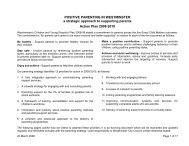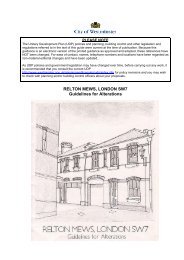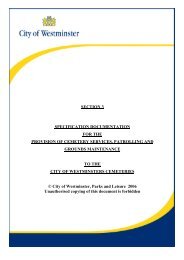Energy Efficiency in Conservation Areas - Westminster City Council
Energy Efficiency in Conservation Areas - Westminster City Council
Energy Efficiency in Conservation Areas - Westminster City Council
- No tags were found...
Create successful ePaper yourself
Turn your PDF publications into a flip-book with our unique Google optimized e-Paper software.
Insulation<strong>Energy</strong> <strong>Efficiency</strong> <strong>in</strong> <strong>Conservation</strong> <strong>Areas</strong>Materials<strong>Energy</strong> <strong>Efficiency</strong> <strong>in</strong> <strong>Conservation</strong> <strong>Areas</strong>Key Pr<strong>in</strong>ciplesInsulat<strong>in</strong>g a build<strong>in</strong>g envelope is essential toimprove energy efficiency. Add<strong>in</strong>g or <strong>in</strong>creas<strong>in</strong>g<strong>in</strong>sulation to floors, walls, roofs and <strong>in</strong>creas<strong>in</strong>g thethermal performance of w<strong>in</strong>dows and doors (seepages 9 & 10) can be achieved <strong>in</strong> various ways.The choice of technique will depend on theconstruction of the build<strong>in</strong>g, on cost limits and onplann<strong>in</strong>g restrictions.When <strong>in</strong>stall<strong>in</strong>g <strong>in</strong>sulation the follow<strong>in</strong>g keypr<strong>in</strong>ciples should be followed to ensure GoodPractice, to achieve maximum energy efficiencyand cost effectiveness:• Carry out <strong>in</strong>sulation as part of an<strong>in</strong>tegrated energy efficiencyrefurbishment strategy;• Use as much <strong>in</strong>sulation as possible -generally the benefits <strong>in</strong>crease with<strong>in</strong>sulation depth;• Ensure by dew-po<strong>in</strong>t calculation that<strong>in</strong>terstitial condensation will not occurwith<strong>in</strong> the construction;• Ensure that the <strong>in</strong>sulation is cont<strong>in</strong>uousparticularly at floor, wall and roof junctionsso that thermal bridg<strong>in</strong>g does not occur(see page 5);• Ensure that the method of <strong>in</strong>sulation doesnot cause or aggravate rot or dampnessproblems;• Use <strong>in</strong>sulation with Zero Ozone DepletionPotential (ZODP) to prevent contribut<strong>in</strong>gto global warm<strong>in</strong>g.Ground Floors & BasementsGround floors are responsible for a significantamount of heat loss, up to 10%, so <strong>in</strong>sulationshould be considered dur<strong>in</strong>g refurbishment work.Plann<strong>in</strong>g guidance is given on page 6.Rais<strong>in</strong>g floors is undesirable where it disturbsorig<strong>in</strong>al features such as stone or til<strong>in</strong>g, or <strong>in</strong>volvesalter<strong>in</strong>g exist<strong>in</strong>g doors, staircases and lift access.However, some methods allow orig<strong>in</strong>al floors andlevels to be ma<strong>in</strong>ta<strong>in</strong>ed or rebuilt. Alternatively,external perimeter trench <strong>in</strong>sulation can be used.Solid floor <strong>in</strong>sulation• is normally cost effective if replac<strong>in</strong>g afloor or exist<strong>in</strong>g screen, which avoidsrais<strong>in</strong>g floor levels• can be placed under the slab if replac<strong>in</strong>ga floor, which allows a solid floor f<strong>in</strong>ish tobe built• can be placed above the slab, topped byboards, <strong>in</strong> place of an exist<strong>in</strong>g screen (seeabove)• needs technical advice if work<strong>in</strong>g withorig<strong>in</strong>al floors e.g. stone, earth or limeconcreteSuspended floor <strong>in</strong>sulation• normally easy & worthwhile if accessavailable from below, or if renew<strong>in</strong>gfloorboards (see left)• raises floor levels when added on top ofexist<strong>in</strong>g timber floors with battens andnew boards• needs draughtstripp<strong>in</strong>g between floor,skirt<strong>in</strong>gs & panell<strong>in</strong>g with ventilation tovoids underneath• should use open jo<strong>in</strong>ted boards or nett<strong>in</strong>gto support <strong>in</strong>sulation and avoid trapp<strong>in</strong>gspilt liquidsInsulationAll <strong>in</strong>sulants should have zero ODP. Some<strong>in</strong>sulants, e.g. some cavity wall <strong>in</strong>sulationmaterials have health hazard concerns, otherssuch as m<strong>in</strong>eral fibre, use large amounts ofenergy <strong>in</strong> their production: up to 30 times that ofsheep wool. Other natural materials such as hempand flax are available and cork (see top right) isalso appropriate for use <strong>in</strong> flat roof<strong>in</strong>g. Recycledcellulose <strong>in</strong>sulation (see middle right) can be used<strong>in</strong> roofs and suspended floors.PVC-free build<strong>in</strong>gsThere are significant concerns about thesusta<strong>in</strong>ability of PVC products <strong>in</strong> terms ofpollutants, longevity, ma<strong>in</strong>ta<strong>in</strong>ability and disposal.It is possible to produce susta<strong>in</strong>able PVC-freebuild<strong>in</strong>gs, with timber w<strong>in</strong>dows and doors, castiron ra<strong>in</strong>water goods, LSF or OHLS cabl<strong>in</strong>g andclay dra<strong>in</strong>age.Transport of materialsAs with labour and skills, it is important to uselocally sourced materials wherever possible, toreduce the pollution aris<strong>in</strong>g from and the energy<strong>in</strong>volved <strong>in</strong> the transport of bulky build<strong>in</strong>gmaterials.Repair and reuseGood design and detail<strong>in</strong>g and the repair orreplacement with like for like ensures that thebuild<strong>in</strong>g performance is not affected. Use recycledor reused materials wherever possible but ensurethat they are sourced from a reputable supplier.Materials & construction adviceThe AECB ‘Greener Build<strong>in</strong>g’ directory is a goodsource book for the environmental selection ofmaterials. ACTAC produce the ‘Green Build<strong>in</strong>gDigest: a guide to build<strong>in</strong>g products and theirimpact on the environment’. The BRE producevarious publications concern<strong>in</strong>g the environmentalselection of materials, such as ‘The Green Guideto Specification’ and produce numerous GoodPractice Guides such as that opposite. SeeContacts on the back page for all of the above.3 16
















